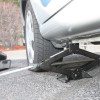| Specifications of the First generation MINI Cooper |
|
| Production |
2001-2006 (Mk I Hardtop)
2005-2008 (Mk I Convertible) |
Class |
compact |
| Body style(s) |
3-door hatchback
2-door convertible |
Engine(s) |
1.4L Tritec I4 (One)1.4L Toyota 1ND-TV diesel (D)
1.6L Tritec I4 (One, Cooper)1.6L Tritec supercharged I4 (S) |
| Transmission(s) |
CVT
5-speed manual
6-speed automatic and manual |
Wheelbase |
97.1 in (2,470 mm) |
| Length |
2002-03 Base: 142.8 in (3,630 mm)
2004-06 Base & Convertible: 143.1 in (3,630 mm)
S Hardtop & Convertible: 143.9 in (3,660 mm) |
Width |
66.5 in (1,690 mm) |
| Height |
2002-03 Base: 55.9 in (1,420 mm)
2002-03 S: 56.2 in (1,430 mm)
2004-06 Base: 55.4 in (1,410 mm)
2004-06 S: 55.8 in (1,420 mm)
2004-06 Convertible: 55.5 in (1,410 mm) |
Kerb weight |
2,496 lb (1,132 kg) |
In Portugal and Greece, the Mini One was powered by a 1.4 litre I4 version of the Tritec engine but all other petrol powered Minis used the 1.6 litre I4 version.
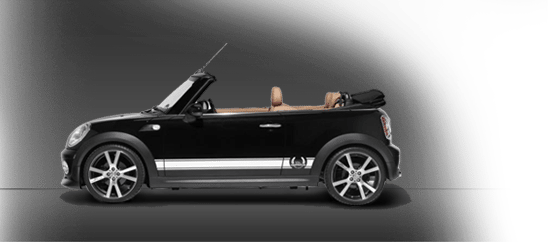 Since 2005, a soft-top convertible option has been available across the entire range. There are numerous styling and badging differences between the models, perhaps the most obvious being that the Cooper S has a distinctive scoop cut into the bonnet. The Cooper S also has twin exhausts which exit under the centre of the rear valance. The (non-S) Cooper has more chrome parts than the Mini One and has a single exhaust. The Mini One D has no visible exhaust pipes at all.
Since 2005, a soft-top convertible option has been available across the entire range. There are numerous styling and badging differences between the models, perhaps the most obvious being that the Cooper S has a distinctive scoop cut into the bonnet. The Cooper S also has twin exhausts which exit under the centre of the rear valance. The (non-S) Cooper has more chrome parts than the Mini One and has a single exhaust. The Mini One D has no visible exhaust pipes at all.
In some markets, such as Australia and the U.S., only the Mini Cooper and Cooper S are offered because the Mini One’s engine was considered inadequate to deliver sufficient power to run an air conditioner – a necessary feature in those markets. Almost fifty percent of all Minis sold in Australia and about seventy percent of those sold in the U.S. are the more-powerful Cooper S model. Other models of note, sold in varying markets around the world, are the Mini Seven, Mini Park Lane, Mini Check Mate, and Mini Monte Carlo.
The names Cooper and Cooper S echo the names used for the sportier version of the classic Mini, which in turn come from the involvement of John Cooper and the Cooper Car Company. The Cooper heritage is further emphasized with the John Cooper Works (JCW) range of tuning options that are available with the Mini. John Cooper also created a one-off racing model of the Mini Cooper S named the Mini Cooper S Works. This car features many extras which help to improve performance, such as a racing exhaust and air filter as well as uprated suspension. The car also has one-of-a-kind 17-inch (430 mm) racing wheels. Brazilian-built Tritec engine, co-developed by Chrysler & BMW; the Mini One D used a Toyota-built diesel engine. In August 2006, BMW announced that future engines would be built in the UK, making the car essentially British-built again; final assembly took place at Cowley, and the body pressings were made in nearby Swindon at BMW’s Swindon Pressings Ltd subsidiary.
All models used a transversely-mounted four-cylinder engine driving the front wheels. All four wheels are pushed to the corners of the body to improve handling. The styling of the car, like that of the Volkswagen’s New Beetle, is a retro design that is deliberately reminiscent of the original Mini. The retro styling is further enhanced by retaining other classic Mini touches such as contrasting roof colours, optional bonnet stripes, optional rally lights, and black trim around the wheel arches and rocker panels that mimic the wide wheel flares found on many classic Minis.
The Mini One and Mini Cooper were available with a ZF VT1F continuously variable transmission or with a conventional Midlands five-speed manual transmission (model years 2001-2004); the latter was replaced with a Getrag five-speed unit for the remainder of the Mk I production (2005-2006). The Cooper S came with a six-speed Getrag manual or (starting with the 2005 model year) a fully automatic transmission with paddle shifters. As standard, the Mini had a drive by wire electronic throttle, electronic brakeforce distribution, cornering brake control and electronic stability control (standard or optional, depending on model and region) to improve control and handling in adverse conditions.
The addition of a supercharger to the Mk I Cooper S required that the battery be relocated into the rear of the car – leaving no room for a spare tyre; hence this model comes with run-flat tyres as standard.
MINI Convertible
Salon International de l’Auto, Mini introduced a convertible model which was released in the 2005 model year and available in One, Cooper and Cooper S versions.
The convertible roof is fully automatic – an unusual feature in such a small car – and can be opened partially to act as a sunroof whilst the car is driving at speed. The convertible model forsakes the rear hatchback of the Hardtop Mini, replacing it with a drop down ‘tailgate’ that is reminiscent of the classic Mini – it incorporates similarly prominent external hinges, and with the roof in the closed position, the rear roof section and luggage shelf can be raised with two handles, semi-tailgate style, to access the luggage space easier. The convertible also adds two small power windows for the rear seat passengers which are lowered automatically when the roof opens. The roof is made from a heavy cloth, with many layers of insulation; the rear window is glass with an integral heater/defroster, but no washer or wiper.
At the 2007 North American International Auto Show, Mini introduced the limited edition Mini Cooper S Sidewalk Convertible. It had a top speed of 215 km/h (134 mph) and accelerates from 0 to 100 kilometres per hour (0 to 62 mph) in 7.9 seconds. The engine provides 168 hp (125 kW) and 220 N·m (160 ft·lbf) of torque.
MINI John Cooper Works GP
The last Mk I variant to be produced using the Tritec engine was the Mini Cooper S with John Cooper Works GP Kit: a light-weight, quasi-race-prepped John Cooper Works model. Hand-finished by Bertone in Italy, it was offered as a limited-production run of 2000 cars during the 2006 model year, with 444 of those originally intended for the UK market (although ultimately, 459 were sold). The GP features more bolstered front seats but had no rear seats, which along with reduced sound-deadening, removal of the rear wash-wipe system, optional air-conditioning, and other weight-reduction steps, resulted in a weight saving of around 40 kg (88 lb) compared to a Cooper S.
Additionally, the car had enhanced braking, suspension, a smooth under-body and 218 hp (163 kW) from the John Cooper Works engine modification package. In place of the rear seats there is additional body stiffening and below-floor storage areas. The car also offered many unique styling points, such as the red door mirrors, a carbon fiber rear spoiler, unique body kit, bespoke (2 kg lighter) 4-spoke alloy wheels, and specialized badging.
Available in just one color scheme (Thunder Blue with a Pure Silver roof), each car was individually numbered and featured a decal on the roof along with a plaque on the dashboard. The last of the supercharged Minis and a genuine Limited Edition model, there is a high potential for the Mini Cooper S with John Cooper Works GP Kit to become a collector’s item.
Mini Hatch/Hardtop (2007 to present)
A 2009 Mini Cooper Hatch.
 Mini introduced an all-new, second generation of the Hardtop/Hatch model in November 2006, on a re-engineered platform incorporating many stylistic and engineering changes. It utilises the Prince engine, the architecture of which is shared with PSA Peugeot Citroën and is designed to be more cost-effective and fuel-efficient, and is manufactured at the BMW Hams Hall engine plant in Warwickshire, United Kingdom. The development and engineering was done in Munich, Germany at BMW Group headquarters, and by external third parties. Although the new model looks very similar to its predecessor, every panel was different and new safety requirements resulted in the overall length increasing by 60 mm (2.4 in).
Mini introduced an all-new, second generation of the Hardtop/Hatch model in November 2006, on a re-engineered platform incorporating many stylistic and engineering changes. It utilises the Prince engine, the architecture of which is shared with PSA Peugeot Citroën and is designed to be more cost-effective and fuel-efficient, and is manufactured at the BMW Hams Hall engine plant in Warwickshire, United Kingdom. The development and engineering was done in Munich, Germany at BMW Group headquarters, and by external third parties. Although the new model looks very similar to its predecessor, every panel was different and new safety requirements resulted in the overall length increasing by 60 mm (2.4 in).
The second generation Mini was introduced in the Cooper and Cooper S trim levels; the range was added to in 2007 with the Mini One. For the first time, there was a diesel-powered Cooper, available from April 2007, and badged as the Cooper D, which was supplemented in January 2011 with a new 2.0 L diesel for the automatic Cooper and high performance Cooper SD. The Convertible and Clubman versions followed later. In 2009, the Mini First trim level was launched in the UK, which is a low-end, petrol-only version, with less power and a lower speed. The Mini John Cooper Works Challenge is a purpose-built race car, based on the Mini Hatch, and manufactured in the BMW Motorsport factory located in Munich. It was unveiled in 2007 at the IAA Motor Show. In 2009 a John Cooper Works World Championship 50 special edition was unveiled in 2009 Mini United Festival in Silverstone.
Mini Clubman (2008 to present)
A 2009 Mini Cooper Clubman
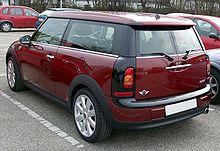 The Mini Clubman is an estate Mini, introduced for the 2008 model year and available in One, Cooper, Cooper S, and Cooper D variations. While identical to the Hatch/Hardtop from the B-pillars forward, the Clubman is 240 mm (9.4 in) longer overall, with a correspondingly stretched wheelbase that is 80 mm (3.1 in) longer; this provides more rear-seat leg room and substantially increased cargo space when compared to the Hardtop — 160 mm (6.3 in) longer, giving 260 litres (9.2 cubic feet) of space. It has twin “barn doors,” alternately referred to as “the Splitdoor,” enclosing the boot instead of a pull-up hatch, and also features a “Clubdoor” on the right-hand side regardless of the intended market. This means that in right-hand drive markets (including the car’s home market), the rear door is on the road side of the car, requiring rear passengers to exit into the road.
The Mini Clubman is an estate Mini, introduced for the 2008 model year and available in One, Cooper, Cooper S, and Cooper D variations. While identical to the Hatch/Hardtop from the B-pillars forward, the Clubman is 240 mm (9.4 in) longer overall, with a correspondingly stretched wheelbase that is 80 mm (3.1 in) longer; this provides more rear-seat leg room and substantially increased cargo space when compared to the Hardtop — 160 mm (6.3 in) longer, giving 260 litres (9.2 cubic feet) of space. It has twin “barn doors,” alternately referred to as “the Splitdoor,” enclosing the boot instead of a pull-up hatch, and also features a “Clubdoor” on the right-hand side regardless of the intended market. This means that in right-hand drive markets (including the car’s home market), the rear door is on the road side of the car, requiring rear passengers to exit into the road.
Engine and transmission selections are identical to those used in the Hatch/Hardtop model, except the 66 kW (90 PS; 89 hp) One Diesel; and the rear suspension set-up shares many of the same designs features including the rear trailing arms and the anti-roll bars.
The use of the name “Clubman” for the Mini estate van was a break with classic Mini tradition. “Clubman” was originally the name given to the 1970s face-lift of the classic Mini, which mostly resulted in a squared-off front end, whereas the classic Mini estates had traditionally been named “Traveller” or “Countryman”. However, BMW did not initially purchase the rights to use those names.
Mini Convertible (2009 to present)
A 2009 Mini Cooper Convertible
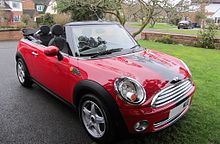 The second generation Mini Convertible was unveiled at the 2009 Detroit Auto Show and the 2009 Geneva International Motor Show as a 2009 model-year vehicle (first available for sale on 28 March 2009). A device, marketed as the “Openometer”, records the number of minutes the vehicle has operated with its roof retracted. Available variants and corresponding powertrain selections are the same as in the Mini Hatch range, including the diesel engine in some markets.
The second generation Mini Convertible was unveiled at the 2009 Detroit Auto Show and the 2009 Geneva International Motor Show as a 2009 model-year vehicle (first available for sale on 28 March 2009). A device, marketed as the “Openometer”, records the number of minutes the vehicle has operated with its roof retracted. Available variants and corresponding powertrain selections are the same as in the Mini Hatch range, including the diesel engine in some markets.
Mini Countryman (2011 to present)
A 2010 Mini Cooper S Countryman
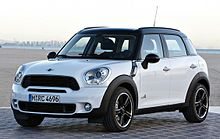 The Mini Countryman was announced in January 2010, and formally launched at the 2010 Geneva Motor Show. It is the first Mini crossover SUV, and the first five-door model to be launched in the BMW-era. It is offered with a choice of two- or four-wheel drive (known as ALL4), and with 1.6 L petrol or diesel and 2.0 L diesel four-cylinder engines in various states of tune. Sales started in September 2010 as a 2011 model-year vehicle.
The Mini Countryman was announced in January 2010, and formally launched at the 2010 Geneva Motor Show. It is the first Mini crossover SUV, and the first five-door model to be launched in the BMW-era. It is offered with a choice of two- or four-wheel drive (known as ALL4), and with 1.6 L petrol or diesel and 2.0 L diesel four-cylinder engines in various states of tune. Sales started in September 2010 as a 2011 model-year vehicle.
The Countryman has a longer wheelbase, more interior room, and higher ground clearance than the Clubman. It uses the same engines as the Hatch/Clubman range, but with an optional all-wheel-drive powertrain (dubbed “ALL4”) to allow minimal off-road and rugged terrain driving. A six-speedmanual transmission is standard on all models, with automatic transmission available on all petrol and diesel models except the 90 bhp One D.
Mini Coupé (2012 to present)
Mini John Cooper Works Coupé
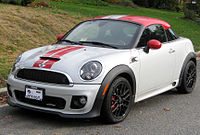 Mini revealed the Coupé in June 2011. It is the first two-seat Mini and the first to have a three-box design; the engine compartment, the passenger compartment and the luggage compartments are all separated. It will also be the fastest production Mini ever – in John Cooper Works trim it does 0 to 62 mph (0 to 100 km/h) in 6.4 seconds and goes on to a top speed of 149 mph (240 km/h) thanks to a turbocharged 208 hp (155 kW) 1,598 cc four-cylinder.
Mini revealed the Coupé in June 2011. It is the first two-seat Mini and the first to have a three-box design; the engine compartment, the passenger compartment and the luggage compartments are all separated. It will also be the fastest production Mini ever – in John Cooper Works trim it does 0 to 62 mph (0 to 100 km/h) in 6.4 seconds and goes on to a top speed of 149 mph (240 km/h) thanks to a turbocharged 208 hp (155 kW) 1,598 cc four-cylinder.
Mini Roadster (2012 to present)
A 2012 Mini Cooper Roadster
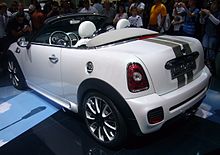 The Mini Roadster was first shown at the Frankfurt Motor Show in September 2009 and is the convertible version of the Mini Coupe. Like other Mini models, the Roadster is available in three trim levels: Cooper, Cooper S, and John Cooper Works.
The Mini Roadster was first shown at the Frankfurt Motor Show in September 2009 and is the convertible version of the Mini Coupe. Like other Mini models, the Roadster is available in three trim levels: Cooper, Cooper S, and John Cooper Works.

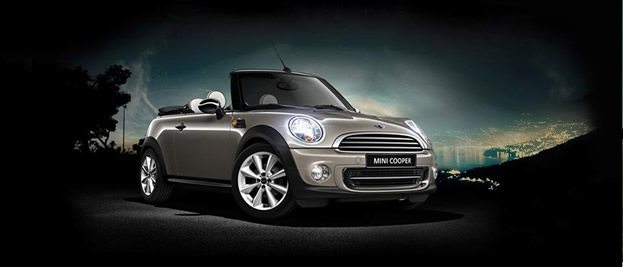
 Since 2005, a soft-top convertible option has been available across the entire range. There are numerous styling and badging differences between the models, perhaps the most obvious being that the Cooper S has a distinctive scoop cut into the bonnet. The Cooper S also has twin exhausts which exit under the centre of the rear valance. The (non-S) Cooper has more chrome parts than the Mini One and has a single exhaust. The Mini One D has no visible exhaust pipes at all.
Since 2005, a soft-top convertible option has been available across the entire range. There are numerous styling and badging differences between the models, perhaps the most obvious being that the Cooper S has a distinctive scoop cut into the bonnet. The Cooper S also has twin exhausts which exit under the centre of the rear valance. The (non-S) Cooper has more chrome parts than the Mini One and has a single exhaust. The Mini One D has no visible exhaust pipes at all. Mini introduced an all-new, second generation of the Hardtop/Hatch model in November 2006, on a re-engineered platform incorporating many stylistic and engineering changes. It utilises the Prince engine, the architecture of which is shared with PSA Peugeot Citroën and is designed to be more cost-effective and fuel-efficient, and is manufactured at the BMW Hams Hall engine plant in Warwickshire, United Kingdom. The development and engineering was done in Munich, Germany at BMW Group headquarters, and by external third parties. Although the new model looks very similar to its predecessor, every panel was different and new safety requirements resulted in the overall length increasing by 60 mm (2.4 in).
Mini introduced an all-new, second generation of the Hardtop/Hatch model in November 2006, on a re-engineered platform incorporating many stylistic and engineering changes. It utilises the Prince engine, the architecture of which is shared with PSA Peugeot Citroën and is designed to be more cost-effective and fuel-efficient, and is manufactured at the BMW Hams Hall engine plant in Warwickshire, United Kingdom. The development and engineering was done in Munich, Germany at BMW Group headquarters, and by external third parties. Although the new model looks very similar to its predecessor, every panel was different and new safety requirements resulted in the overall length increasing by 60 mm (2.4 in). The Mini Clubman is an estate Mini, introduced for the 2008 model year and available in One, Cooper, Cooper S, and Cooper D variations. While identical to the Hatch/Hardtop from the B-pillars forward, the Clubman is 240 mm (9.4 in) longer overall, with a correspondingly stretched wheelbase that is 80 mm (3.1 in) longer; this provides more rear-seat leg room and substantially increased cargo space when compared to the Hardtop — 160 mm (6.3 in) longer, giving 260 litres (9.2 cubic feet) of space. It has twin “barn doors,” alternately referred to as “the Splitdoor,” enclosing the boot instead of a pull-up hatch, and also features a “Clubdoor” on the right-hand side regardless of the intended market. This means that in right-hand drive markets (including the car’s home market), the rear door is on the road side of the car, requiring rear passengers to exit into the road.
The Mini Clubman is an estate Mini, introduced for the 2008 model year and available in One, Cooper, Cooper S, and Cooper D variations. While identical to the Hatch/Hardtop from the B-pillars forward, the Clubman is 240 mm (9.4 in) longer overall, with a correspondingly stretched wheelbase that is 80 mm (3.1 in) longer; this provides more rear-seat leg room and substantially increased cargo space when compared to the Hardtop — 160 mm (6.3 in) longer, giving 260 litres (9.2 cubic feet) of space. It has twin “barn doors,” alternately referred to as “the Splitdoor,” enclosing the boot instead of a pull-up hatch, and also features a “Clubdoor” on the right-hand side regardless of the intended market. This means that in right-hand drive markets (including the car’s home market), the rear door is on the road side of the car, requiring rear passengers to exit into the road. The second generation Mini Convertible was unveiled at the 2009 Detroit Auto Show and the 2009 Geneva International Motor Show as a 2009 model-year vehicle (first available for sale on 28 March 2009). A device, marketed as the “Openometer”, records the number of minutes the vehicle has operated with its roof retracted. Available variants and corresponding powertrain selections are the same as in the Mini Hatch range, including the diesel engine in some markets.
The second generation Mini Convertible was unveiled at the 2009 Detroit Auto Show and the 2009 Geneva International Motor Show as a 2009 model-year vehicle (first available for sale on 28 March 2009). A device, marketed as the “Openometer”, records the number of minutes the vehicle has operated with its roof retracted. Available variants and corresponding powertrain selections are the same as in the Mini Hatch range, including the diesel engine in some markets.
 Mini revealed the Coupé in June 2011. It is the first two-seat Mini and the first to have a three-box design; the engine compartment, the passenger compartment and the luggage compartments are all separated. It will also be the fastest production Mini ever – in John Cooper Works trim it does 0 to 62 mph (0 to 100 km/h) in 6.4 seconds and goes on to a top speed of 149 mph (240 km/h) thanks to a turbocharged 208 hp (155 kW) 1,598 cc four-cylinder.
Mini revealed the Coupé in June 2011. It is the first two-seat Mini and the first to have a three-box design; the engine compartment, the passenger compartment and the luggage compartments are all separated. It will also be the fastest production Mini ever – in John Cooper Works trim it does 0 to 62 mph (0 to 100 km/h) in 6.4 seconds and goes on to a top speed of 149 mph (240 km/h) thanks to a turbocharged 208 hp (155 kW) 1,598 cc four-cylinder.


